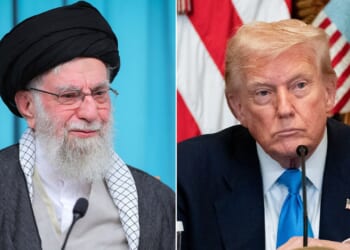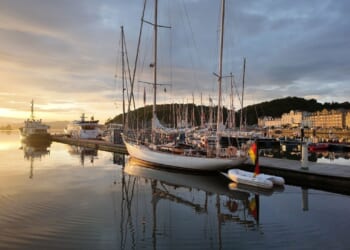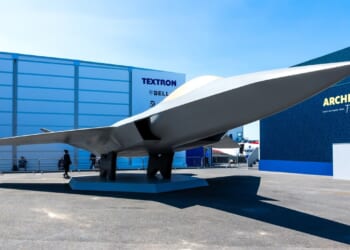As in World War II, naval and air power can cripple an enemy, but they must be able to reach him first. Unsinkable support bases are indispensable in a far-flung maritime theater.
This is the second article of a two-part series examining America’s past and present Expeditionary Advanced Base Doctrine. Part 1 can be found here.
80 years after the end of the Second World War, American attention has turned once again to the Western Pacific. Today, however, the potential adversary is Communist China rather than Imperial Japan. China is building and training a powerful navy, as did Japan before it. And, like Tokyo, Beijing is expanding its sphere of influence into the resource-rich Indo-Pacific region, which is also home to a primary global trade route through the Strait of Malacca.
In accordance with this mission, China is building artificial islands in the South China Sea, partially to enforce its disputed territorial claims with Vietnam, Malaysia, Brunei, the Philippines, and Taiwan. Those islands also serve as a stout protective ring from which land-based troops, aircraft, and missile batteries can protect the homeland and coastal trade and logistical corridors. They would be key assets in China’s anti-access/area-denial (A2/AD) strategy. Chinese aircraft and long-range missiles allow them to assume strategic defensive roles, even in operationally-offensive actions such as an attack on Taiwan.
A future war with China would still require American forces to cross the Pacific, but the situation in that regard is far better than the one America faced in 1941. Well-developed bases on Okinawa, Guam, the Philippines, and the support of allies like Australia, and, ironically, Japan, give the US military a distinct advantage denied to its forebears.
The “Expeditionary Advanced Base” Concept
But the distances are still vast, requiring a coherent plan for forward land support of naval and air operations. To that end, the US military has begun projecting power into the Pacific, and no service has altered its approach to that end more than the Marines. Like it did a century ago, the Corps is transitioning from conventional land warfare and counterinsurgency back to its maritime roots.
In 2021, the Marines published the Tentative Manual for Expeditionary Advanced Base Operations (TM-EABO)—which specifically modeled its approach on 1921’s revolutionary Advanced Base Operations in Micronesia, the 1934 Tentative Manual for Landing Operations, and the Navy’s FTP 167, Landing Operations Doctrine. These manuals comprised the American amphibious playbook during the Second World War. A second edition TM-EABO was published in 2023, building on the first edition.
Like their predecessors, the TM-EABOs address Expeditionary Advanced Base Operations (EABO) concepts as part of establishing a modern doctrine for their employment. Digging into those weeds is unnecessary here, but the essential concept has not changed appreciably over the last century.
The Indo-Pacific is inherently a maritime environment. Naval and air power cannot secure victory on their own, no matter how dominant they are. EABO recognizes the need for land-based forward support of fleet and air operations to facilitate power projection against an enemy. It also positions ground forces to seize and hold territory to secure further bases as an enemy is pushed back. World War II island assaults were all about securing logistical bases, airfields, and fleet anchorages to move American striking power closer to Japan. The islands themselves were worthless if they did not further those efforts.
Likewise, any potential shooting war against China would require ground forces to take and hold islands in the South and East China Seas. Those critical islands would host unsinkable missile batteries, airfields, and logistical nodes, as well as threaten Chinese maritime efforts and even the mainland if required. Advanced Base Doctrine recognizes the crucial role played by land forces in a maritime theater.
What Role Can Land Forces Play in the Indo-Pacific?
The Marines are leading the way, but Advanced Base operations were never solely a Marine Corps endeavor. The US Army played key roles in the Pacific War at places like Guadalcanal, Makin, Saipan, Okinawa, New Guinea, and the Philippines. The Army’s participation would be critical in any modern conflict as well.
First, the Marine Corps lacks the numbers to cover every aspect of a maritime war with China. That alone would require Army participation. But the Army would also provide a level of ground-based fire support the Marines can’t match, especially with the larger service’s emerging hypersonic weapons capability.
The Army and Marines have been training with Australian and other allied troops for just such a contingency and have prepositioned equipment across the region. Army Patriot Missile batteries have conducted live-fire exercises in Palau, Australia, and the Philippines. The Army’s logistical capabilities would be absolutely indispensable. In other words, the Marines are developing the doctrine, in conjunction with their joint partners, but EABO is an all-service endeavor.
As in World War II, naval and air power can cripple an enemy, but they must be able to reach him first. Unsinkable support bases are indispensable in a far-flung maritime theater, as the Indo-Pacific most assuredly is. Though Imperial Japan ultimately squandered the luxury of strategic defense, it enjoyed it for a time, as does Communist China today. That alignment requires the ability to establish forward operating bases from which to assail those defenses.
Operating from Hawaii or the continental United States was not practical in 1944-45. Nor is it practical now, even with far longer-range weapons. The Marine Corps’ revival of the EABO concept shows they can learn from the past to fight a potential future war. The vast and unforgiving Pacific demands no less.
Of course, American EABO and other operational concepts versus Chinese A2/AD systems will hopefully remain an intellectual exercise. Any real confrontation would be bloody for both sides with no certain outcomes. But the preparatory work must still be done. Pete Ellis would approve.
About the Author: William Lawson
William Lawson is a military historian focusing on World War II and 20th century conflicts and the American Civil War. His specialty is operational level warfare, especially American amphibious doctrine. He writes on history, politics, and firearms for multiple publications and historical journals. He serves on the editorial advisory board for the Saber & Scroll Journal and Military History Chronicles and is a member of the Society for Military History and the American Historical Association. Lawson is based in Virginia.
Image: Shutterstock / rikinik.
















